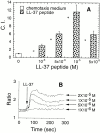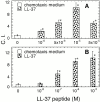LL-37, the neutrophil granule- and epithelial cell-derived cathelicidin, utilizes formyl peptide receptor-like 1 (FPRL1) as a receptor to chemoattract human peripheral blood neutrophils, monocytes, and T cells
- PMID: 11015447
- PMCID: PMC2193321
- DOI: 10.1084/jem.192.7.1069
LL-37, the neutrophil granule- and epithelial cell-derived cathelicidin, utilizes formyl peptide receptor-like 1 (FPRL1) as a receptor to chemoattract human peripheral blood neutrophils, monocytes, and T cells
Abstract
We have previously shown that antimicrobial peptides like defensins have the capacity to mobilize leukocytes in host defense. LL-37 is the cleaved antimicrobial 37-residue, COOH-terminal peptide of hCAP18 (human cationic antimicrobial protein with a molecular size of 18 kD), the only identified member in humans of a family of proteins called cathelicidins. LL-37/hCAP18 is produced by neutrophils and various epithelial cells. Here we report that LL-37 is chemotactic for, and can induce Ca(2+) mobilization in, human monocytes and formyl peptide receptor-like 1 (FPRL1)-transfected human embryonic kidney 293 cells. LL-37-induced Ca(2+) mobilization in monocytes can also be cross-desensitized by an FPRL1-specific agonist. Furthermore, LL-37 is also chemotactic for human neutrophils and T lymphocytes that are known to express FPRL1. Our results suggest that, in addition to its microbicidal activity, LL-37 may contribute to innate and adaptive immunity by recruiting neutrophils, monocytes, and T cells to sites of microbial invasion by interacting with FPRL1.
Figures




References
-
- Lehrer R.I., Ganz T. Antimicrobial peptides in mammalian and insect host defense. Curr. Opin. Immunol. 1999;11:23–27. - PubMed
-
- Cowland J.B., Johnsen A.H., Borregaad N. hCAP-18, a cathelin/pro-bactenecin-like protein of human neutrophil specific granules. FEBS Lett. 1995;368:173–176. - PubMed
-
- Zanetti M., Gennaro R., Romeo D. Cathelicidinsa novel protein family with a common proregion and a variable C-terminal antimicrobial domain. FEBS Lett. 1995;374:1–5. - PubMed
Publication types
MeSH terms
Substances
Grants and funding
LinkOut - more resources
Full Text Sources
Other Literature Sources
Medical
Molecular Biology Databases
Miscellaneous

